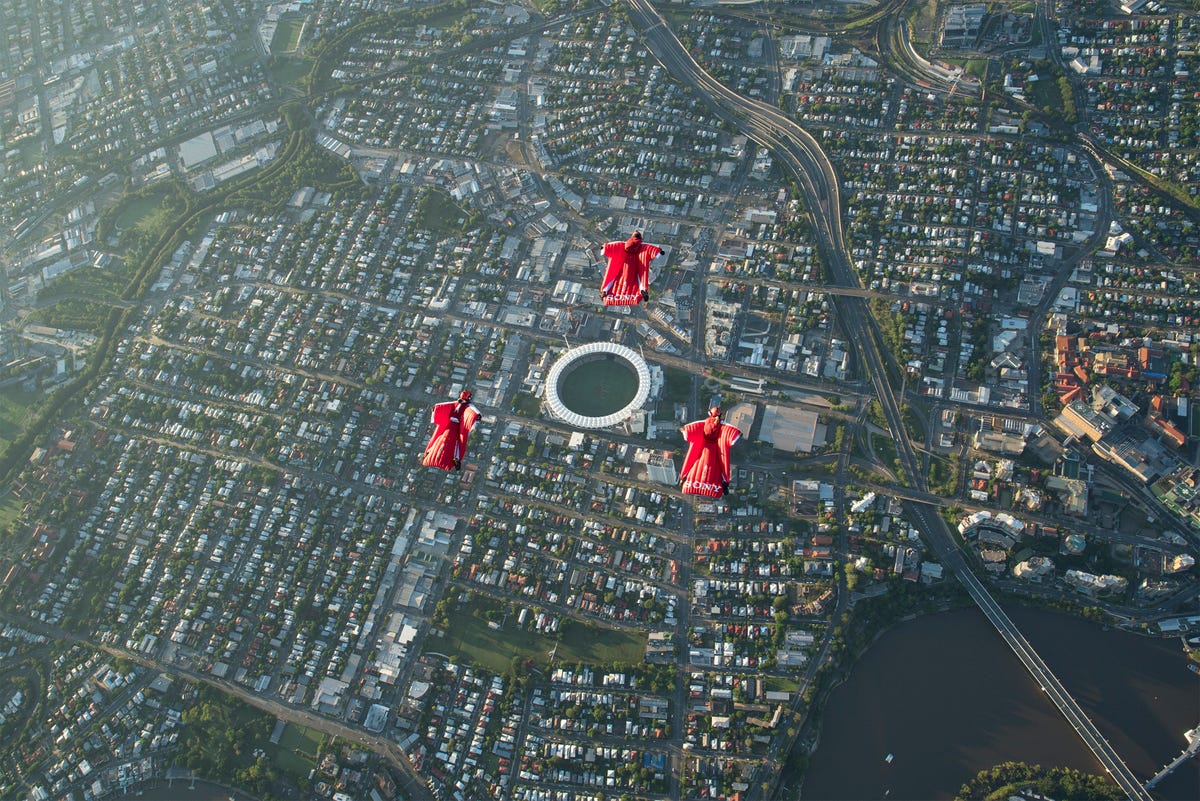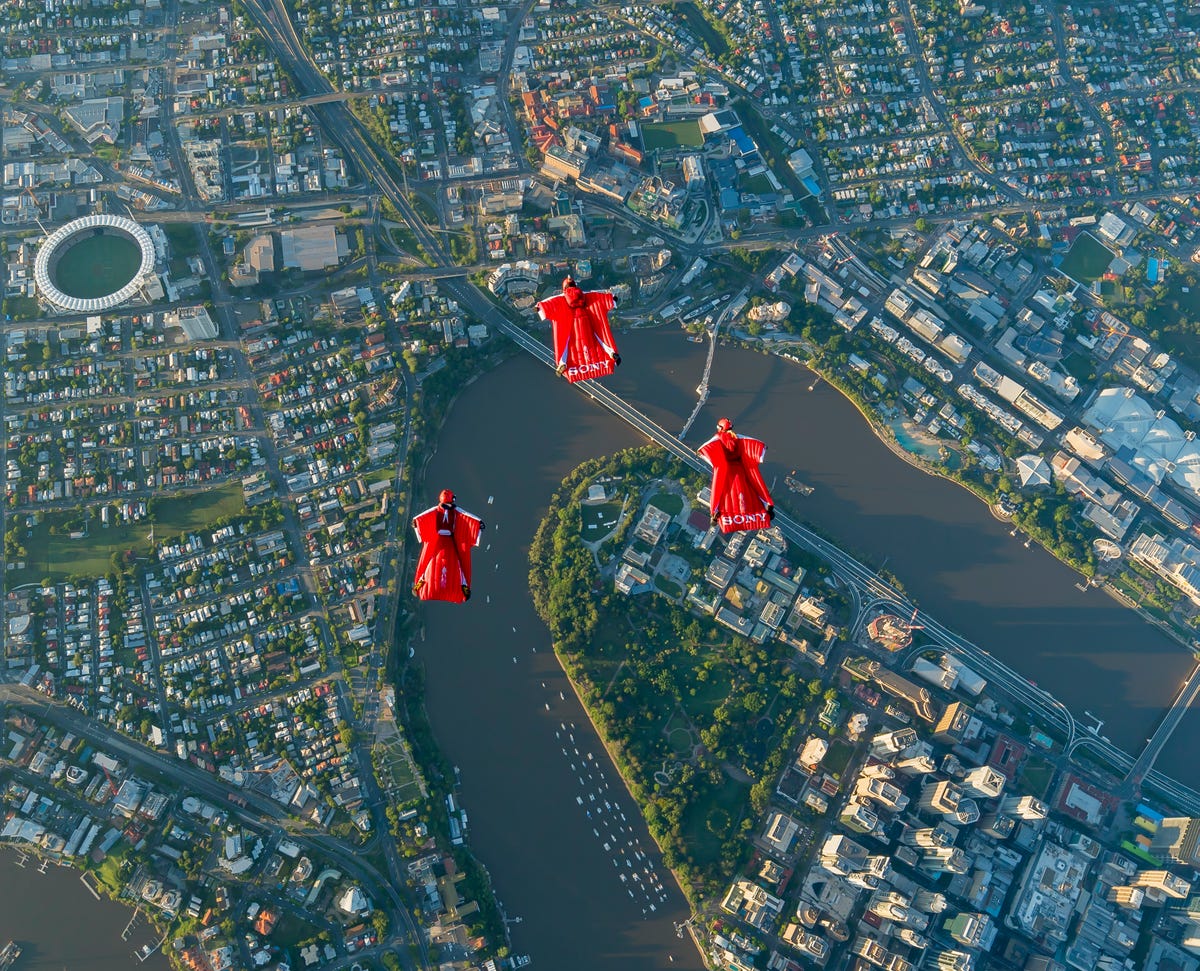
Paul Tozer
“The first time I’m going to see the Grand Canyon is when I fly over it!” Dr. Glenn Singleman exclaimed when I asked if he’d need to study the landscape of his most challenging wingsuit flight yet.
In April, Singleman and his team will attempt the first wingsuit flight over the Grand Canyon. At 8 kilometres (or 5 miles) across, it’s no mean feat.
Wingsuits are gravity-powered gliders that help propel their pilots/wearers during flight. Made of zero porosity nylon, each suit is custom-manufactured to exact dimensions. The suits have a glide ratio of 3-to-1, which means they travel forward at three times the speed they descend. Pilots can achieve speeds of 200 kilometres (124 miles) per hour going forward, and fall toward the ground at 70 kilometres (43 miles) per hour.
To complete the Grand Canyon flight safely, the team has to exit the launch plane from 30,000 feet — the cruising altitude of a commercial airliner.
“Because we’re going to 30,000 feet there’s the risk of getting the bends, so we need to prebreathe pure oxygen for an hour before the plane goes up,” said Singleman. “Then once we’re up, we’re still breathing 100 percent oxygen.”
Once the team exits the plane, the flight down lasts only from five to seven minutes. Each suit has 19 minutes’ worth of oxygen in its wings as redundancy.
In preparation for the Grand Canyon, Singleman’s team, including his wife, Heather Swan; Vicente Cajiga; Roger Hugelshofer; and Paul Tozer, have been in training. They successfully completed the world’s first wingsuit flight over Brisbane, Australia, on Sunday.


Paul Tozer
Previous efforts have included a flight over Sydney Harbour and a hot-air-balloon jump over the Australian outback. Singleman and Swan hold the record for the highest wingsuit “BASE” jump (“building, antenna, span and earth”) — a jump from a cliff or a fixed structure. They jumped from Mt. Meru in India. It took them three weeks to climb the mountain and just three minutes to fly down from it.
Flying high
“While it just looks like people in squirrel suits, the technology is incredibly sophisticated,” said Singleman.
The oxygen is supplied through military-grade masks normally used by fighter pilots. If that sounds a bit “Top Gun”, the pilots also have equipment more common to land-based activities.
On the helmets, Sena Bluetooth communication devices used by motorcycle riders let the team talk to one another during the flight. A FlySight GPS device “speaks” to the pilot through the speaker system, giving them information on glide ratio. There’s also an altimeter to deliver audio cues when they reach set heights, so they know exactly when to release their parachute.
See how a wingsuit pilot takes to the sky (pictures)






+6 more
When he first started jumping, Singleman was using a 16mm film camera to capture the flight. On the helmet, it would create vibrations as it recorded during the descent. Reviewing the footage was a slow process too, as it involved taking the film out in a dark bag and developing it first.
Fast-forward to 2015 and the equipment is much more refined. For both the Brisbane and Grand Canyon jumps, the team is using a Sony A7S camera with 16-35mm lens, an AX100 4K camcorder and several AS-100V Action Cams.
The small Action Cams are positioned on the sides of the helmets and set to record before the team jumps out of the plane. Paul Tozer is in charge of the cinematography on the bigger cameras, filming the flight on the camcorder and A7S mounted side-by-side on his helmet.
While the camcorder captures the entire journey, the A7S is triggered by a bite switch located in Tozer’s helmet. Used by skydivers, the bite switch is a mouth-operated trigger that fires a camera’s shutter when bitten. The camera can then grab bursts of images in continuous mode.
Tozer has to build the strength in his neck to cope with the strain from having two cameras on his helmet. When the parachute opens, flyers go from 200 kilometres per hour to 20 in the space of a few seconds.
From test flights, the team found they were able to get the best results by setting focus on the cameras just short of infinity, and leaving them on automatic exposure. The huge variance in dynamic range when flying from such a height means that automatic exposure does a better job than manual in this situation.
“We get one chance,” Singleman said. “We wanted to get the A7S because when we go over the Grand Canyon, it’s morning and there will be a huge [variance] in contrast, and that’s the only thing I know that will be able to get the stills.”


Paul Tozer
“With all the other cameras we’ve ever used, I’ve never been able to see the symbol [on the back of the wingsuit]. It’s usually just a smudge. But now you can actually see it,” said Singleman.
Despite all the technology currently built in to wingsuits, Singleman has one particular item on his wish list. “What we want and what we’re waiting for is for someone to build a heads-up display on the mask,” he said.
“It would tell us our speed, direction and where the drop zone is. We’re limited [because] we can’t jump through cloud, we’re not allowed to. It’s OK if there’s cloud around, we can fly around it, but if there is cloud between us and the ground, we can’t see the drop zone and we’re not supposed to jump.”
Winging it
Not only do the flyers have to concentrate on all the equipment needed to complete the record-breaking attempt, flying over one of the world’s most iconic locations presented its own series of regulatory challenges.
It took a year to get all the necessary clearances. Even then, the team can’t jump whenever it wants to. The Grand Canyon is near a major flight path from New York to Los Angeles and as a result, Singleman’s team has a six-minute window in which to complete its jump on April 7: between 7:38 and 7:44 a.m. local time precisely.
“We’re pretty confident that we’ll get the five miles across the Grand Canyon, but it’s one of those things where you’re doing it at high altitude, there’s lots of stress, you get one bite…there’s six minutes and you’ve got to go.”
Singleman said safety was one of the motivating factors behind doing a wingsuit flight rather than a BASE wingsuit jump from the canyon. “Lots of people watch YouTube and think ‘oh, I’m going wingsuit BASE jumping next weekend’ and unfortunately there’s a lot of people who have paid a very big price for that experience,” he said.


Paul Tozer
“We decided that we liked the idea of getting the maximum performance out of the suit. Those people that you see on YouTube who fly down the cliff are actually flying the suit very badly. You’ll always see them with their arms behind them because they have got to fall next to the cliff to follow that terrain. Whereas we’re interested in flying as flat as possible so we can go as far as possible. It’s high-performance flying.”
For those of us who will never experience the sensation of wingsuit flight, Singleman said it’s transcendental. “You get into that trancelike state, and you’re flying!”
At least we’re still able to experience some of the sensation from the comfort of our screens.




